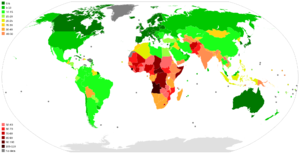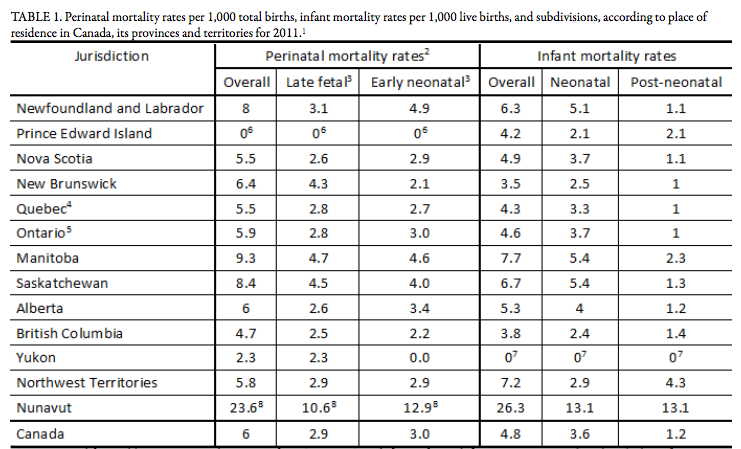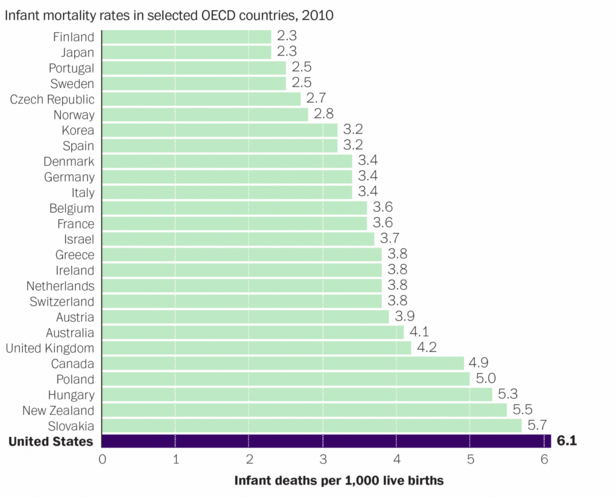GRSJ224/infantmortality
Infant Mortality
Infant mortality is the death of an infant younger than the age of one. There are multiple different cause including preterm birth, sudden infant death syndrome, and maternal complications of pregnancy. For every 1,000 babies born, it is said that six die before their first birthday. Infant mortality is greatly affected by factors such as ethnicity, race, environment of birth, and SES. However, perhaps the most important of these factors is the health of the mother before the baby is born.

Definition
Infant Mortality is defined by Collins English Dictionary as follows :
- noun
- 1. deaths among infants [1]
Infant Mortality Rate is defined by Collins English Dictionary as follows :
- noun
- 1. the number of infant deaths in a given period [2]
Infant mortality refers to the death of a baby before the age of one. ""Infant mortality rate"" (IMR) is the ratio of the number of deaths of children under one year of age per 1,000 live births in the same year. Infant mortality rate is often used as a standard indicator of population health of a nation because it shows the health status of the mother and child. This in turn can reflect the health and medical conditions, as well as public access to such services. [3]
Types of Infant Related Mortality
- Perinatal mortality: death between 22 completed weeks of gestation and seven days after birth [4]
- Neonatal mortality: death of an infant between their first 28 days after birth [5]
- All-cause mortality: all deaths that occur, regardless of what caused them [6]
- Disease-specific mortality: all deaths that occur due to a specific illness [7]
Causes
Sudden Infant Death Syndrome (SIDS): Sudden infant death syndrome is defined as "the sudden death of an infant under one year of age, which remains unexplained after a thorough case investigation, including performance of a complete autopsy, examination of the death scene, and review of the clinical history". [8] It is the leading cause of death for infants in developed countries, even after SIDS rates have declined. [9] More than the first month of life, SIDS are more common and peaks between 2 and 4 months of age. There has been a decline in SIDS worldwide, however it still remains to be a serious issue. There are numerous factors that may contribute to SIDS such ask demographic factors, maternal smoking, sleep practices, breastfeeding, and genetic factors. [10]
Maternal complications of pregnancy: Maternal complications of pregnancy refers to health problems occurring during pregnancy to mothers, their baby, or both. Some experience such problems before becoming pregnant and some have them during pregnancy. In order to decrease the risk of having complications, it is crucial for women expecting and going through pregnancy to seek and receive appropriate and needed health care. [11] Before pregnancy, speaking to your doctor and receiving any possible treatment available for your health problem can help reduce risks. It is also important to take into account that certain medicines or treatments can be harmful when pregnant. Discussing any health problems during previous pregnancy with your doctor can help contribute to finding preventions as well. During pregnancy, it may be difficult to determine what symptoms are normal and what needs medical attention. There are numerous different physical and mental discomforts that come with pregnancy, so it is important to go for frequent checkups, and also to contact your prenatal care provider if something seems abnormal.
Birth Defects: Birth defects refer to health problems that babies face while still inside the womb. This may include issues with their organs or body parts, their functioning, and other critical roles that are needed for a baby to be born healthy. There exists more than 4,000 kinds of birth defects that range from minor issues to major ones that may need surgical treatment. A structural defect is when a baby is born without a certain body part or one that is malformed, the most common one being heart defects. Another type of defect are metabolic defects. These define defects that prevent the baby's body from breaking down food properly to create energy. [12]
Preterm Birth: Preterm birth is when an infant is born before 37 weeks of pregnancy. The most deaths of preterm born babies occur among those born before 32 weeks, very preterm. The reason why preterm birth increases the risk of death by so much is because babies undergo very important growth during the final weeks of pregnancy. It is when their organ systems fully develop. Preterm birth can cause several problems, aside from possible death:
- Breathing difficulties
- Feeding difficulties
- Cerebral palsy
- Developmental delay
- Vision problems
- Hearing impairment
Preterm birth can be caused by a number of different reasons: [13]
- Tobacco use
- Alcohol use
- Illicit drug use
- Lack of proper nutrition
- Employment
- Physical activity
- Chronic and catastrophic stress exposures
- Social support
Preventions
Sudden Infant Death Syndrome (SIDS): Currently, it is difficult to predict which babies are at risk for SIDS. However, there are some precautions that have been able to reduce the risk.
- Sleep position:
- The baby should be placed on their back during their sleep time - The baby's face should be clear of any coverings - Do not overheat your baby with covers or clothes - No smoking around your baby - The baby should not sleep beside anyone else
- Home monitoring
Birth Defects: Out of the 4,000 different types of birth defects, there are some that can be prevented and some that cannot. For some that can be prevented, taking folic acid and consuming certain amounts of iodine can help immensely. Women should get their vaccinations done before pregnancy and make sure that they do not have any sexually transmitted diseases. Eating a healthy diet and avoiding any alcohol consumption, drugs, and tobacco can also reduce the risk of birth defects. However, most babies with birth defects are born to healthy parents, which makes it very difficult to know how to prevent them beforehand.
Preterm Birth: Preterm birth is a little more challenging to prevent than some other problems. The best way to reduce the risk of preterm labor is to seek early prenatal care, as soon as you know you are going to be pregnant. Your doctor will be able to guide you through your next few months with suggestions of healthy diets, weight, and also provide screenings to find possible infections. Prenatal vitamins and folic acid is a crucial part of the diet and it is a good idea to start taking these supplements when you are trying to get pregnant.
Infant Mortality Within Countries
Canada

Other Countries

References
- ↑ Infant Mortality."Collins English Dictionary" - Complete & Unabridged 10th Edition. Web. 21 Feb. 2016. <http://www.collinsdictionary.com/dictionary/english/infant-mortality>.
- ↑ '"Infant Mortality Rate.'" Collins English Dictionary - Complete & Unabridged 10th Edition. Web. 21 Feb. 2016. <http://www.collinsdictionary.com/dictionary/english/infant-mortality>.
- ↑ McCormick, Marie C. "The Contribution of Low Birth Weight to Infant Mortality and Childhood Morbidity." The New England Journal of Medicine (1985). Web. 22 Feb. 2016. <http://www.nejm.org/doi/pdf/10.1056/NEJM198501103120204>.
- ↑ "Maternal and Perinatal Health." Maternal, Newborn, Child and Adolescent Health. World Health Organization. Web. 22 Feb. 2016. <http://www.who.int/maternal_child_adolescent/topics/maternal/maternal_perinatal/en/>.
- ↑ "Neonatal Mortality." Medical Dictionary. Web. 22 Feb. 2016. <http://medical-dictionary.thefreedictionary.com/neonatal mortality>.
- ↑ "Neonatal Mortality." Medical Dictionary. Web. 22 Feb. 2016. <http://medical-dictionary.thefreedictionary.com/neonatal mortality>.
- ↑ "Neonatal Mortality." Medical Dictionary. Web. 22 Feb. 2016. <http://medical-dictionary.thefreedictionary.com/neonatal mortality>.
- ↑ Willinger M, James LS, Catz C. Defi ning the sudden infant death syndrome (SIDS): deliberations of an expert panel convened by the National Institute of Child Health and Human Development. Pediatr Pathol 1991; 11: 677–84.
- ↑ Moon, Rachel Y., Rosemary SC Horne, and Fern R. Hauck. "Sudden infant death syndrome." The Lancet 370.9598 (2007): 1578-1587.
- ↑ Moon, Rachel Y., Rosemary SC Horne, and Fern R. Hauck. "Sudden infant death syndrome." The Lancet 370.9598 (2007): 1578-1587.
- ↑ Roberts, James M., et al. "Vitamins C and E to prevent complications of pregnancy-associated hypertension." New England Journal of Medicine 362.14 (2010): 1282-1291.
- ↑ Heinonen, Olli P., Dennis Slone, and Samuel Shapiro. Birth defects and drugs in pregnancy. Publishing Sciences Group Inc., Littleton, Massachusetts, USA, 1977.
- ↑ Butler, Adrienne Stith, and Richard E. Behrman, eds. Preterm Birth:: Causes, Consequences, and Prevention. National Academies Press, 2007.